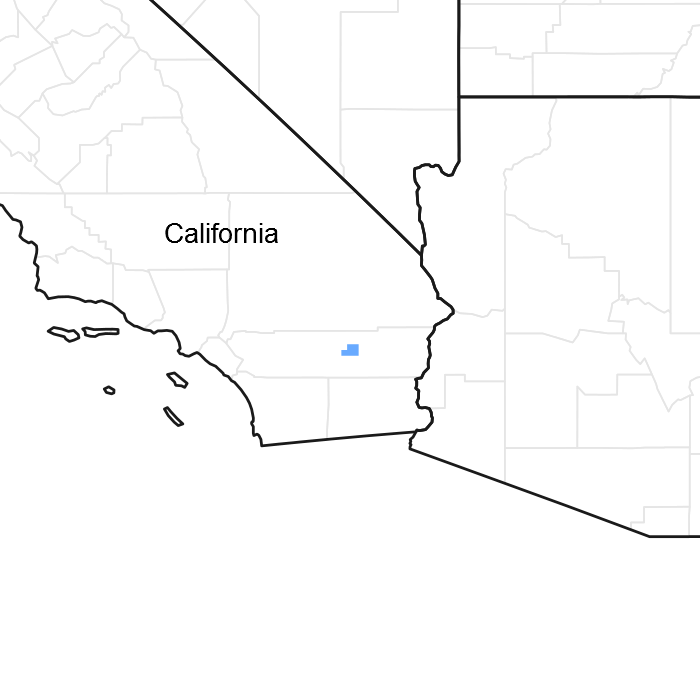

Natural Resources
Conservation Service
Ecological site R030XB228CA
Warm Shallow Pediments
Last updated: 10/21/2024
Accessed: 11/21/2024
General information
Provisional. A provisional ecological site description has undergone quality control and quality assurance review. It contains a working state and transition model and enough information to identify the ecological site.

Figure 1. Mapped extent
Areas shown in blue indicate the maximum mapped extent of this ecological site. Other ecological sites likely occur within the highlighted areas. It is also possible for this ecological site to occur outside of highlighted areas if detailed soil survey has not been completed or recently updated.
MLRA notes
Major Land Resource Area (MLRA): 030X–Mojave Basin and Range
MLRA Description:
Major Land Resource Area (MLRA) 30, Mojave Desert, is found in southern California, southern Nevada, the extreme southwest corner of Utah and northwestern Arizona within the Basin and Range Province of the Intermontane Plateaus. The climate of the area is hot (primarily hyperthermic and thermic; however at higher elevations, generally above 5000 feet, mesic, cryic and frigid) and dry (aridic). Elevations range from below sea level to over 12,000 feet in the higher mountain areas found within the MLRA. Due to the extreme elevational range found within this MLRA, Land Resource Units (LRUs) were designated to group the MLRA into similar land units.
LRU Description:
This LRU (designated by ’XB’) is found across the eastern half of California, much of the mid-elevations of Nevada, the southernmost portions of western Utah, and the mid-elevations of northwestern Arizona. Elevations range from 1800 to 5000 feet and precipitation ranges from 4 to 9 inches per year, but is generally between 5-6 inches. This LRU is characterized primarily by the summer precipitation it receives, ranging from 18 – 35% but averages 25%. Summer precipitation falls between July and September in the form of rain, and winter precipitation falls starting in November and ends between February and March, also mostly in the form of rain; however it does receive between 0 and 3 inches of snow, with an average of 1 inch. The soil temperature regime is thermic and the soil moisture regime is typic-aridic. Vegetation includes creosote bush, burrobush, Nevada jointfir, ratany, Mojave yucca, Joshua tree, chollas, cactus, big galleta grass and several other warm season grasses. At the upper portions of the LRU, plant production and diversity are greater and blackbrush is a common dominant shrub.
Ecological Site Concept -
This ecological site occurs on pediments located relatively far from receding mountain fronts, and thus subject to relatively low rates of erosion, at elevations of 2310 to 3330 feet. It occurs on warm thermic, very shallow to shallow soils.
Production Reference Value (RV) is 195 pounds per acre and ranges from 90 to 305 pounds per acre. The site is dominated by creosote bush (Larrea tridentata) and burrobush (Ambrosia dumosa). Relative to surrounding fan aprons, a high diversity of secondary shrubs is present. A warm thermic environment and relatively low levels of erosion supports dominance by creosote bush and burrobush. Low soil moisture holding capacity in shallow soils reduces productivity relative to surrounding fan aprons. Localized run-off from dissected topography provides microsites for a greater diversity of species than is found on surrounding fan aprons.
Data in the following sections is from all components (major and minor) that are correlated with this ecological site.
This site is part of group concept R030XA030CA
Classification relationships
Larrea tridentata Shrubland Alliance (Sawyer et al. 2009).
Associated sites
| R030XB005NV |
Arid Active Alluvial Fans This ecological site occurs on adjacent fan aprons. Creosote bush (Larrea tridentata) and burrobush (Ambrosia dumosa) dominate. |
|---|---|
| R030XB140CA |
Shallow Hill 4-6" P.Z. This ecological site occurs on adjacent hillslopes. Burrobush (Ambrosia dumosa) is dominant. |
| R030XB225CA |
Warm Sloping Pediments This ecological site occurs on adjacent pediments. Hall's shrubby spurge (Tetracoccus hallii) and burrobush (Ambrosia dumosa) dominate. |
| R030XD003CA |
Hyperthermic Steep South Slopes This ecological site occurs on south-facing adjacent mountain slopes. Brittlebush (Encelia farinosa) is dominant. |
Similar sites
| R030XB221CA |
Loamy Fan Remnants And Pediments This ecological site occurs on pediments and fan remnants with moderately deep soils to a duripan. It is dominated by blackbrush (Coleogyne ramosissima), burrobush (Ambrosia dumosa) and Hall’s shrubby spurge (Tetracoccus hallii). |
|---|---|
| R030XB225CA |
Warm Sloping Pediments This ecological site occurs on pediments located closer to the mountain front, where erosion rates are greater, and the landscape is more dissected. This site is co-dominated by Hall’s shrubby spurge (Tetracoccus hallii) and burrobush (Ambrosia dumosa). Creosote bush (Larrea tridentata) is a secondary species. |
Table 1. Dominant plant species
| Tree |
Not specified |
|---|---|
| Shrub |
(1) Larrea tridentata |
| Herbaceous |
(1) Malacothrix glabrata |
Click on box and path labels to scroll to the respective text.

